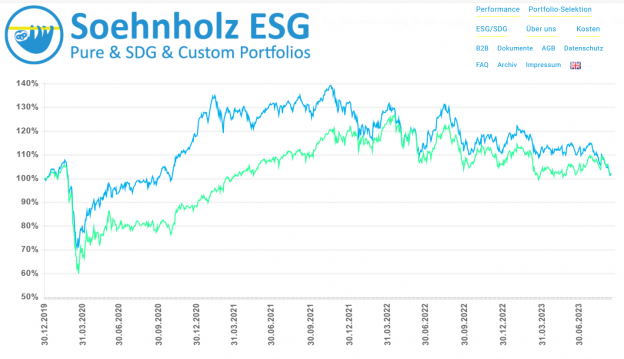Alternatives: Thematic investments can take up (part) of the allocation which alternative investments should have had in the past. The main reason is a stricter focus on responsible investments. Here I explain, why I support this development:
Extensive alternative and responsible investment experience
I started my financial services career trying to select the best private equity funds worldwide. Soon, I also covered hedge funds, real estate funds and infrastructure funds. In my current multi-asset portfolios, alternatives have a share between a quarter and a third of the portfolios.
In 2015, I developed three innovative ETF-Portfolios. One passively diversified multi-asset portfolio, one pure alternative investment portfolio and one ESG portfolio. The multi-asset ETF-portfolio and the ESG ETF-portfolio will be continued whereas I decided to stop the active offer of my alternatives ETF-Portfolio and will focus on my (multi-theme) SDG ETF-portfolio, instead. I follow a similar approach by replacing my direct listed alternatives ESG-portfolios with SDG-aligend investments.
My traditional multi-asset allocations will not change
My rather large allocation to alternatives is based on scientific studies of aggregated asset allocations of investors worldwide. I use ETFs not only for traditional equity and bond allocations but also for alternative investments. I have documented this most-passive asset allocation approach in detail in my Soehnholz ESG and SDG portfolio book. This approach is and will be applied to my traditional (non-ESG) Weltmarkt ETF-Portfolio and to my multi asset ESG ETF-Portfolio also in the years to come.
Stand-alone alternatives portfolios scrapped from my offering
There are two reasons for my decision to stop offering stand-alone alternatives portfolios: First, I want to focus on even stricter responsible investing and second, I could not find many investors for my “alternatives” portfolios.
The alternatives portfolios were offered to diversify traditional and ESG investment portfolios and I still think that this makes a lot of sense. Unfortunately, the returns of most alternatives market segments lagged the ones of traditional large-cap equities more or less since the start of my portfolios in 2016/2017. And low returns have not been good for sales.
It may well be that the timing of my decision is bad and that market segments such as listed (ESG) infrastructure and (ESG) real estate will perform especially well in the (near) future. But SDG-aligned investments did not perform well, either (see ESG gemischt, SDG schlecht: 9-Monatsperformance 2023 – Responsible Investment Research Blog (prof-soehnholz.com). I expect that they may recover soon. Performance, therefore, did not play a role in my decision.
The reason is, that I want to focus even more than in the past on responsible investments. Therefore, stopping the active offer of my „non-ESG“ alternatives ETF-portfolio should be obvious. But I will also stop to actively offer my direct listed real estate ESG and my listed infrastructure ESG portfolio.
I started similar portfolios at my previous employer in 2013 when there were no such products available in Germany. In 2016, with my own company, I began to offer such portfolios with much stricter ESG-criteria. I could find enough REITs and listed real estate stocks. For listed infrastructure, even though I extended my ideal definition from core infrastructure to also include social infrastructure and infrastructure related companies, I struggled to find 30 companies worldwide which fulfilled my responsibility requirements.
Thematic SDG-aligned portfolios can fill the “alternatives” allocation
But I will not give up on allocations to alternative investments. In the future, most of my actively offered portfolios will be SDG-aligned. I also use ESG-selection criteria in addition to SDG-alignment for all of these portfolios. And my SDG-aligned portfolios have significant exposures to “alternative” investment segments including green and social real estate and infrastructure.
My SDG ETF-Portfolio, for example, currently includes 10 Article 9 ETFs (see Drittes SDG ETF-Portfolio: Konform mit Art. 9 SFDR – Responsible Investment Research Blog (prof-soehnholz.com)). Several of these ETFs invest in infrastructure (e.g. the Clean Water, Clean Energy and Smart City Infrastructure ETF). Two others are purely real estate focused. In addition, my SDG-ETFs are selected as portfolio-diversifiers and typically include a significant number of small cap investments which often have “private equity like” characteristics. Also, SDG-aligned ETF are only admitted for my portfolios if they have a low country- and company-overlap with traditional indices.
And my direct Global Equities ESG SDG portfolios and my mutual fund include about 20% “responsible” infrastructure and 7% social (healthcare and senior housing) real estate stocks in September 2023. In addition, almost half of the stocks in the portfolio are small cap investments (compare Active or impact investing? – (prof-soehnholz.com)).
Both ETF- and direct SDG-aligned portfolios thus can diversify most traditional (large-cap) portfolios. In addition, I will offer investors the ability to easily create bespoke SDG-aligned ESG-portfolios which may well focus on “alternatives”.
Even the performance of my Alternatives ETF- (green in the chart above) and the SDG-ETF portfolio (blue) have been similar for quite some time.

